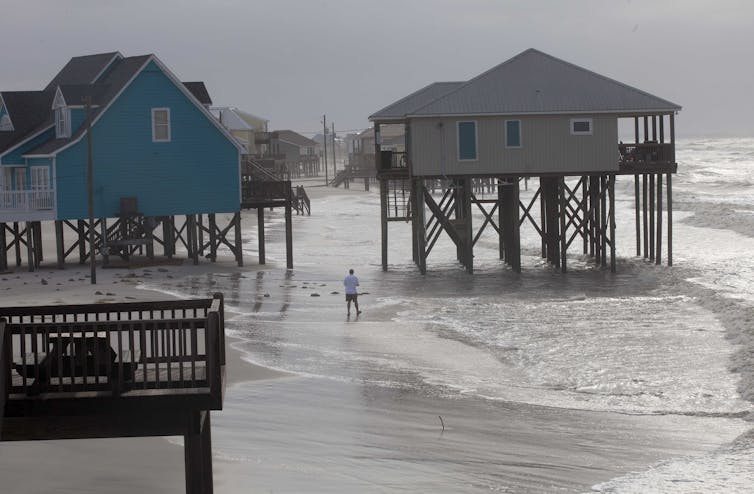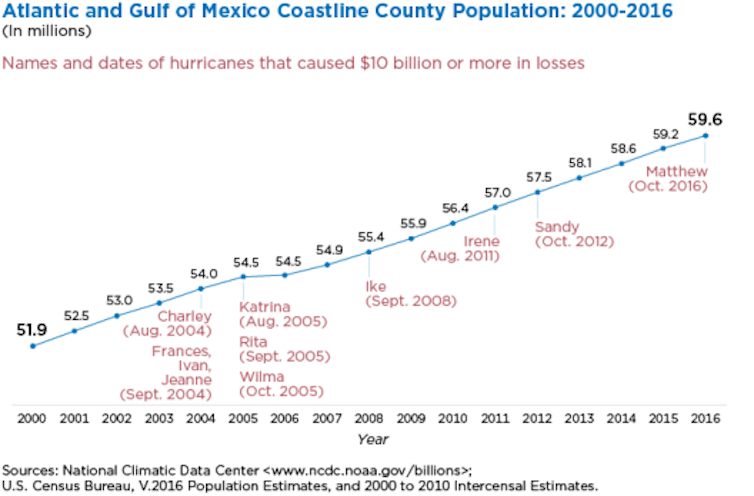Eli Lazarus, University of Southampton and Evan B. Goldstein, University of North Carolina – Greensboro
 U.S. coastal counties are densely populated and extensively developed. They also are directly exposed to sea level rise and storms, which scientists predict will become more destructive as climate change progresses.
U.S. coastal counties are densely populated and extensively developed. They also are directly exposed to sea level rise and storms, which scientists predict will become more destructive as climate change progresses. But despite forward-looking environmental management and land-use planning intended to reduce future risk, development trends in many coastal locations are running in the opposite direction.
As geoscientists, we are interested in natural physical processes of coastal change and in how human decisions interact with natural processes.
In our research on broad development trends in hurricane alleys of the U.S. Atlantic and Gulf coasts, we have found that houses rebuilt in the years following a hurricane typically increased in size relative to their original footprints.
In other words, these homes were built back bigger in places known to be vulnerable to coastal hazards. Recognizing the emerging pattern of these risky investments is an important step toward understanding why people are making them in the first place.
As critics point out, federal disaster aid and subsidized flood insurance are funded with taxpayer dollars, so Americans far from the coasts effectively subsidize development in hazardous areas.
Expanding footprints
Although coastal shoreline counties (excluding Alaska) account for less than 10% of total U.S. land area, in 2010 they were home to 39% of the national population. Between 1970 and 2010, coastal shoreline counties added 3.5 times more people per square mile than the nation as a whole.
Hurricanes are a well-known hazard along the Atlantic and Gulf coasts. The 2018 Atlantic hurricane season included 15 named storms, of which eight were hurricanes. Two became major systems: Hurricane Florence (Category 4) and Hurricane Michael (Category 5), with a combined estimated total of US$50 billion in damages.
Even an average season, as NOAA is forecasting for 2019, might include 12 named storms, with six becoming hurricanes and three reaching intensities of at least Category 3.

This means coastal property owners stand a good chance of being in a storm’s path in any given year.
But it remains unclear how they factor coastal hazards into their economic decisions. Relatively few studies have tracked long-term patterns of socio-economic recovery and demographic change after Atlantic hurricane strikes.
In the 1990s coastal researchers started reporting anecdotally that they were seeing houses that had been destroyed by major storms rebuilt later to larger dimensions.
They describe occurrences in South Carolina after Hurricane Hugo in 1989; Massachusetts after the Halloween Storm of 1991; and New Jersey after storms in 1962, 1984 and 1992.
Seeking to quantify these descriptions, we examined a total of nearly 5,000 building footprints in five beach communities that were hit by hurricanes between 2003 and 2016: Mantoloking, New Jersey; Hatteras, North Carolina; Santa Rosa Island, Florida; Dauphin Island, Alabama; and Bolivar, Texas.
Our data, which we digitized from satellite imagery, bore out descriptions of building back bigger. Moreover, we found that houses newly constructed (not rebuilt) after hurricanes in these communities tended to be larger than houses that predated the hurricanes.
What could explain this pattern? With so many possible drivers, we don’t yet know the answer, but two potentially important factors stand out: variances from local planning laws and engineered hazard protections.
Is bigger better?
Many coastal communities have updated their building codes in recent decades in order to make houses less prone to damage in major storms.
But storm-proofing improvements are not silver bullets.
A team investigating the Bolivar Peninsula immediately northeast of Galveston, Texas after Hurricane Ike in 2008 found that houses arrayed along the same multi-kilometer stretch of shoreline experienced different kinds of damage.
Homes elevated on pilings sustained more damage from wind than from flooding, while the opposite was true for houses that were not elevated. The properties that fared best tended to be older and built on slightly higher elevations set back from the shoreline.
Another research team modeling impacts from Hurricane Sandy in 2012 on The Rockaways in the New York City borough of Queens found little correlation between building height or ground-surface area and hazard indicators, such as the power and depth of flooding and the strength of wave impacts.
Precautionary regulations are better than nothing, and efforts are growing to provide guidance for “building back better” after disasters. Unfortunately, in many parts of the U.S. it is possible to avoid such requirements.
Properties built prior to the inception of new building codes may receive variances from local planning and enforcement authorities.
Such practices, along with lack of enforcement of existing planning rules, has been well documented in North Carolina and Florida. Homes like the so-called “super house” in Mexico Beach, Florida, which was built with features that far exceeded local building codes and weathered Hurricane Michael in October 2018 with only minor damage, are exceptions, not the rule.
Encouraging risky choices
Engineering projects such as beach nourishment – adding sand to eroded shorelines – and seawalls may also indirectly encourage development. Experts call this pattern, in which hazard protections promote risky land-use decisions, the “safe development paradox.”We are exploring connections between coastal development and beach nourishment projects, and have found that in Florida – the most hurricane-battered state in the U.S. – houses are larger and more numerous in areas that practice beach nourishment.
Moreover, Florida beachfront houses built in the last decade are far larger than older houses, and the relative size difference is most pronounced in nourishment areas.
In another study spanning the entire U.S. Atlantic coast, we found that since beach nourishment became commonplace in 1960, large-scale trends in average rates of shoreline change have reversed.
Using records from the U.S. Geological Survey, we calculated that, before 1960, the Eastern Seaboard was eroding at an average rate of approximately 21 inches (55 centimeters) per year.
Since 1960, however, the direction of average shoreline change has reversed, expanding seaward by approximately 2 inches (5 centimeters) per year – even as sea levels rise. And the greatest reversals have occurred in zones of intensive beach nourishment. Our results suggest that beach nourishment has obscured ongoing erosion enough to make shorelines appear more stable than they actually are.
Getting incentives right
The trend of building back bigger could be blunted if sea level rise begins to affect markets for coastal real estate. But the same trend could arise in other settings, such as urban areas prone to wildfires, if recovery regulations and infrastructure upgrades send the same kind of mixed signals about whether an area is safe to develop.
Ultimately, coastal development is a political issue. With coastal hazards only getting worse, regulators will need to make difficult choices to ensure that development patterns actually trend toward lower future risk.
Eli Lazarus, Associate Professor in Geomorphology, University of Southampton and Evan B. Goldstein, Research Scientist in Geography, Environment, and Sustainability, University of North Carolina – Greensboro
This article is republished from The Conversation under a Creative Commons license. Read the original article.